




The spiders on this page are some of the more common species
found in and around buildings. Most of these spiders typically live in
yards and gardens around residences, but accidently enter buildings
while searching for prey, a mate, or a place to lay their eggs.
| "Wandering" Spiders | |||
 |
 |
 |
 |
"Wandering" spiders do not build webs to capture prey. They are active predators and either move about in search of prey, or sit and wait to ambush prey as it approaches. Most wandering spiders will build silken retreats in which to hide, molt, or lay their eggs.
| "Web-building" Spiders | |||
 |
 |
 |
 |
"Web-building" spiders construct silken webs in which to capture prey. Some species build webs that capture flying or aerial prey (the orb-weavers and cobweb weavers), while other species build webs on or near the ground to capture wandering insects (the sheet web or funnel web spiders). Web-building spiders typically stay within their webs, but adult males will wander in search of adult females.
"Wandering" Spiders
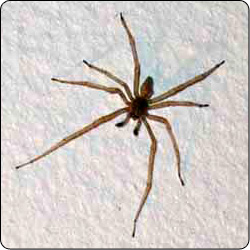 |
back to thumbnail images
Common Name: Yellow Sac Spider Scientific Name: Cheiracanthium sp. Family: Miturgidae Size: body length about 3/8 inch; total length (including legs) about 1 inch. Behavior: These spiders wander in search of prey, and actively chase their prey to catch it. They are most active at night. When and Where to Find: Adults are most common in spring and early summer, although you may see immatures later in the year. In buildings, they are typically observed at night as they search for prey on walls and ceilings. They may build a small white silken retreat (or sac) in which they spend the day. These spiders can also be found on shrubs and deciduous trees. Identification: Both females and males are typically uniformly colored, ranging from yellowish to light brown. |
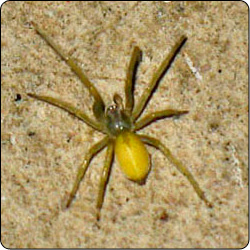 |
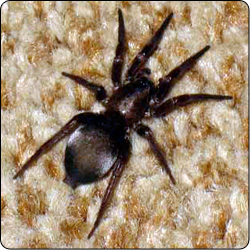 adult female Scotophaeus blackwalli |
back to thumbnail images
Common Name: Ground Spider, or Mouse Spider Scientific Name: Scotophaeus blackwalli Family: Gnaphosidae Size: body length up to about 1/2 inch; total length (including legs) up to about 1 inch. Behavior: These wandering spiders actively chase their prey. They are primarily seen at night when they are foraging, and can run quite quickly. When and Where to Find: These spiders are typically seen from spring through fall. In the home, they are most commonly found on floors in dark areas. Identification: Although these spiders do not spin webs, they possess rather long silk-spinning spinnerets which protrude from the end of the abdomen. Their bodies are often colored a uniform dark brown, sometimes with a metallic sheen. |
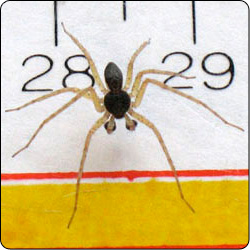 adult male Philodromus |
back to thumbnail images
Common Name: Running Crab Spiders Scientific Name: Philodromus dispar Family: Philodromidae Size: body length about 1/4 inch; total length (including legs) up to about 1/2 inch. Behavior: These spiders do not spin a web, but hunt prey by sitting motionless and ambushing insects as they approach. They hold their first two pairs of legs out to the side while they await prey, which helps give them a crab-like appearance. When and Where to Find: These spiders can be found from late spring through early fall. They are common on vegetation in the garden, but may accidently enter houses as they search for prey or mates. Identification: Immatures and females of this species are light yellow-brown in color, while adult males may have dark brown-black bodies that contrast with their light-colored legs. The second pair of legs in running crab spiders are longer than the other legs. |
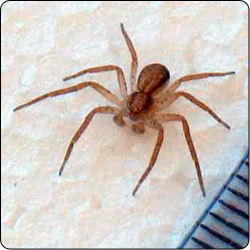 immature male Philodromus |
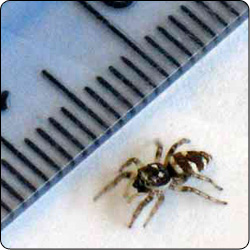 adult female zebra jumper |
back to thumbnail images
Common Name: Zebra Jumper Scientific Name: Salticus scenicus Family: Salticidae (jumping spiders) Size: body length up to about 3/16 inch; total length (including legs) just slightly longer than body length. Behavior: Jumping spiders hunt prey during the day using their keen sense of vision. They will attack insects or other spiders, including prey that is substantially larger than they are. Jumping spiders stalk prey and, once near, attach a line of silk (as a safety anchor) to their substrate, and leap onto their prey. When and Where to Find: These spiders are often found from late spring through early fall. They can be common on the exterior of buildings, and sometimes accidently enter houses in search of prey. Identification: Jumping spiders are easily identified because their front (center) pair of eyes are very large compared to their other six eyes. The zebra spider is black with 3 or 4 pairs of white marks along the sides of its abdomen, and a pair of white marks on its cephalothorax (head). There are other similar-looking jumping spiders in the Portland area. Notes: Jumping spiders can often be handled, and may sit calmly when you pick them up. This family of spiders shows elaborate mating behaviors whereby the male courts the female with a ritualized courtship dance. |
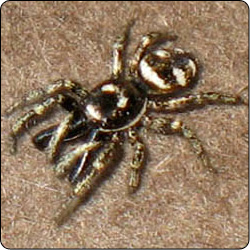 adult male zebra jumper |
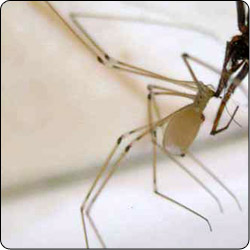 cellar spiders hanging in their webs (webs are not visible in these photographs) |
back to thumbnail images
Common Name: Long-bodied Cellar Spider Scientific Name: Pholcus phalangioides Family: Pholcidae (cellar spiders) Size: body length up to about 7/16 inch, but leg span much larger. Behavior: These long-legged spiders build loose and tangled-looking webs in which they hang to catch their prey. They prey on anything that enters their web — which is often other spiders. They vibrate their webs rapidly when they sense danger (such as when a person approaches them quickly); this vibration obscures their exact location in the web. When and Where to Find: These spiders can be found most of the year hanging from their webs in corners of dimly lit rooms. They are especially common in cellars (hence the common name "cellar spider"), in stairwells or under stairs, and in other less frequently used areas of buildings. These spiders show a close association with human dwellings, and are seldom found in adjacent outdoor gardens. Identification: These slender spiders have very long and thin legs, and are light to medium brown in color. In general appearance, they look similar to harvestmen, or daddy-longlegs (which are not spiders at all, but comprise the arachnid order Opiliones). |
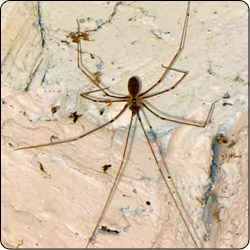 |
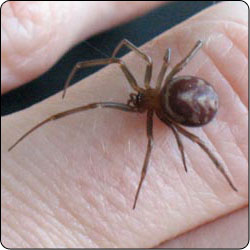 Steatoda cobweb weaving spider |
back to thumbnail images
Common Name: False Black Widow Scientific Name: Steatoda grossa Family: Theridiidae (cobweb weavers) Size: body length about 3/8 inch. Behavior: These spiders build cobwebs, a generally unorganized-looking web with many trip lines that entangle flying and wandering insects or other spiders. Cobweb weavers typically hang upside down in their web and wait for prey. During the day, they often retreat to cover near the web. When and Where to Find: These spiders commonly build their webs in corners of garages, crawl-spaces, or other less frequently used areas. Webs can be found from near ground level to ceiling corners. Identification: These cobweb weaver spiders typically have round abdomens that are much larger than the cephalothorax. |
|
back to thumbnail images
Common Name: European House Spiders, Hobo Spiders, and Barn Funnel Weavers Scientific Name: Tegenaria sp. Family: Agelenidae (funnel web weavers) Three species of Tegenaria funnel web spiders may be encountered around Portland-area residences. These are the barn funnel weaver (Tegenaria domestica), the giant house spider (Tegenaria gigantia), and the hobo spider (Tegenaria agrestis). All of these spiders build funnel webs in dark, moist areas such as in woodpiles, under rocks, or in basements. Distinguishing among the three species can be difficult, and typically needs to be done with the aid of a microscope or hand lens. Size: These spiders vary greatly in size, with the giant house spider the largest of the three species (some are large enough that, from legtip to legtip, they would spread across the entire palm of your hand!). Behavior: Funnel web spiders sit in their sheet webs, often within the funnel portion, and wait for prey to enter their webs. The spiders that people most commonly encounter in their homes are adult males, wandering in search of females. When and Where to Find: Males are most commonly seen during July–September when they wander in search of females. Indoors, they are most frequently found in dimly lit areas such as in boxes, closets, and storage areas. Identification: All three of these spider species are medium brown with variably shaped lighter chevrons on the dorsal (upper) side of the abdomen. These species of funnel weaver spiders cannot readily be distinguished with the naked eye and require examination under magnification. |
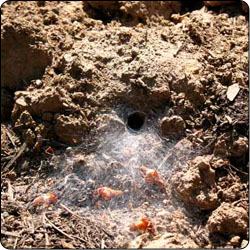 Tegenaria web |
|
Common Name: Common House Spider Scientific Name: Parasteatoda (formerly Achaearanea) tepidariorum |